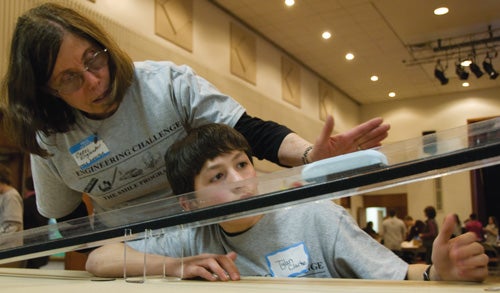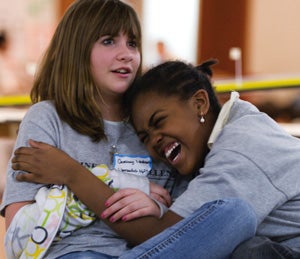SMILE Program
Science and Math Investigative Learning Experience
Inspiring Future Scientists and Engineers—Plus, It’s Fun!

The Scenario
Potholes have pitted the roads of the future, leaving them crumbling and impassable. Bridges and overpasses have warped under the weight of time and overuse. Fuel shortages have driven gas prices into the stratosphere.
The future of transportation depends upon levitation, specifically, a new rail system reliant upon magnetic levitation.
 It’s a challenging engineering problem, but nothing a group of middle school students can’t handle given a day and a $250,000 budget. Imaginary, of course.
It’s a challenging engineering problem, but nothing a group of middle school students can’t handle given a day and a $250,000 budget. Imaginary, of course.
Such are the problems presented to elementary, middle and high school students involved in the University of Rhode Island’s Science and Math Investigative Learning Experience (SMILE), an after-school program serving 240 public school students across the state annually.
This particular transportation problem was one middle school students grappled with last spring at SMILE’s Middle School Engineering Transportation Challenge 2009. The two-day event, held at URI, involved students using wood, pennies, magnetic stripping, rubber bands, foam board and no small amount of ingenuity to create a maglev (think magnetic levitation) car and crane to test on rails.
The Memorial Union Ballroom, the venue for the Challenge, teemed with aspiring engineers intent on solving future transportation issues. Anabely Hernandez, 14, and Ashley Rebelo, 13, students at Providence’s Roger Williams Middle School, sat with Dylan Winward, 12, a student at South Kingstown’s Curtis Corner Middle School, tinkering with their crane and working on their diplomacy.
SMILE Celebrates 15th AnniversaryIn its 15 years, the SMILE program has served thousands of Rhode Island’s elementary-to-high school-aged students and seen 93 percent of its graduates attend college. The program has been nurtured by Carol Englander, SMILE program director and a local middle school science teacher who first heard of SMILE while on sabbatical at Oregon State University in 1994: “I saw all the SMILE clubs there. We would travel around the state and do teacher workshops. Oregon is so huge, which made me think, ‘how hard could this be to do in Rhode Island?’” Englander found funding from local businesses and the program began. SMILE is now 14 clubs strong with school chapters in Providence, East Providence, Central Falls, West Warwick, Woonsocket, and South Kingstown. The school districts each pay for a SMILE program teacher and the attendant professional development required. In addition to events like the middle school engineering challenge held at URI, SMILE also sponsors scientific and career exploration field trips and Family Science Nights to showcase student talent. There is no typical SMILE student, though many are Native American, Hispanic, or African American and roughly 60 percent are female. “Our first graduating class had four girls of color, and they knew they had to do well to pursue the careers they wanted,” Englander said. SMILE also serves students who simply enjoy math, science, and applied learning. “Our goal is to keep kids interested in doing well in school by giving them this outlet where it’s cool to be smart,” said Englander. “Our kids find out that they can be leaders. They develop a lot of self confidence and a sense of camaraderie.” Staying in SMILE is a challenge. Students commit to weekly, two-hour after-school meetings. They must maintain high grades in school, have a good attendance record, and behave appropriately. The cost of the SMILE program is about $1,000 per child. As much as Englander is intent on fostering SMILE students’ love of learning, she is equally committed to cultivating a sense of responsibility in her charges: “A student has to want to be in the program. It’s not enough for a parent to want this, the child has to want it. “I guess when people ask about SMILE—about what keeps kids interested in math and science and doing well in school and going to college—what I want them to know is that we give kids an idea of who they can be. As one student put it, ‘this program opens you up to things you never thought of.’ I like to think we’ve made an investment, and that it’s paying off for Rhode Island.” –By Marybeth Reilly McGreen |
“The problem is trying to figure out how you’re going to put it all together,” said Hernandez.
“They wouldn’t let me touch anything because they were afraid I might break it,” Winward joked.
Hernandez rolled her eyes. “That’s because we had to redo the entire project,” she said in a tone that implied design flaws may have been just part of the problem.
“The challenge is getting along with other people. That’s the real challenge,” said Rebelo.
Making Connections
In the middle of the Memorial Union Ballroom a group of Curtis Corner Middle School students huddle around a plastic rail built for testing the cranes and cars. The student engineers sport oversized grey T-shirts provided by SMILE. A maglev car is about to make its maiden run, its progress along the rails measured by a stopwatch.
“No two cars are quite alike; we haven’t had a lot of industrial espionage,” one adult volunteer notes.
The crane is cranked. The car rolls. Breath is held. Then, success, and a chorus of “yes” from those assembled.
Josh Beck, 12, the keeper of the stopwatch, smiles and notes, “It was really expensive to build. It cost $207,000.”
“Well, you’ve got to pay for quality,” rejoins SMILE Program Director Carol Englander.
In the construction of the crane and maglev car, there were three tasks: To create a design, to construct a prototype, and to test said prototype. The real test, though, was one of teamwork. The students learned that they would not work with their fellow club members; they would be collaborating with students from other participating schools. Select URI students were involved as well in mentoring the middle schoolers. The intent behind mixing the students up was to encourage them to hone their social skills, but it was also about exposing them to university life and the idea that they, too, could find a place there.
“It’s important that the SMILE kids see people who look like them being successful.” Englander explained. “If you’ve never heard a story in your family about going to college, you need a role model.” And the best way to do that, Englander argues, is showing students those who have gone before them not only going to college, but doing well there.
For Francesca Villegas, 13, a Roger Williams Middle School student, the SMILE experience had the desired effect. “I want to come here for college,” Villegas said. “I like the campus. I want to become a kindergarten teacher, I think, or a psychiatrist and a pediatrician.”
“And lunch here is awesome,” said Tylan Clarke, 12, a Curtis Corner Middle School student. “If school lunches were like lunches here, I wouldn’t really mind school as much.”
In addition to the occasional awesome free lunch, SMILE offers long-reaching ancillary benefits to students like Villegas and Clarke. School districts profit from SMILE’s ability to provide enrichment activities for their minority populations. Teachers trained through SMILE acquire hands-on, applied learning knowledge that benefits all their students. SMILE students take what they’ve learned and become leaders in the classroom. And the projects are designed to engage students’ various strengths not only in math and science, but also language arts and graphic design.
“It’s a fun way to learn, and it’s nice to see the growth of a child on this path to success,” Englander said. “If we could figure out how to do it, we’d put a SMILE club in every school.”
-By Marybeth Reilly McGreen
 Home
Home Browse
Browse Close
Close Events
Events Maps
Maps Email
Email Brightspace
Brightspace eCampus
eCampus


